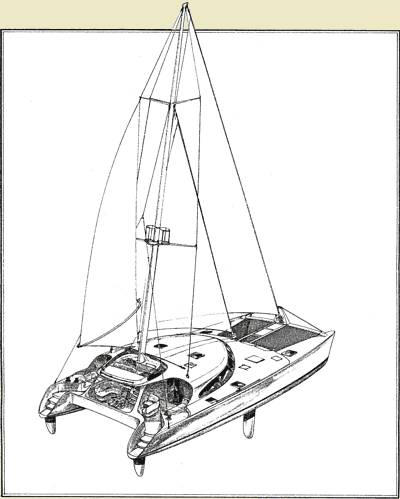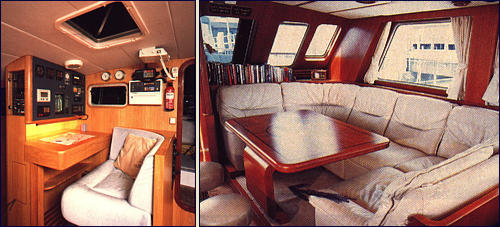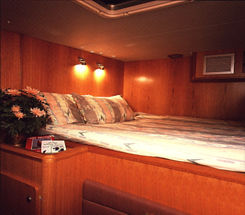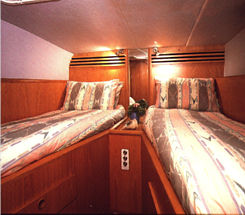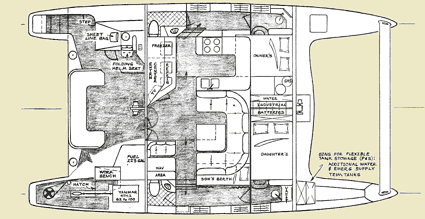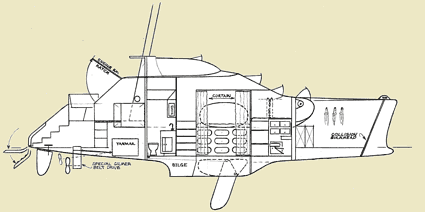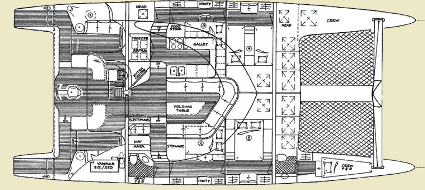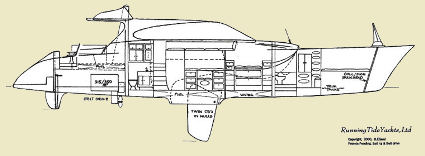
|
Once upon a time many motorsailers were designed, built, and sold. These boats were comfortable and proved very desirable for extensive cruising. Built of wood, strongly framed, and powered with big heavy engines, they were somewhat compromised in sailing ability and certainly did not power at high speeds. They were never expected to do so. Beautiful yachts of this persuasion were designed by Rhodes, Davis, Mason, and Hand to name just a few. These boats were handsome and purposeful. They were motorsailers that went to sea, provided great range and served their owners well. Designs such as these were capable of long voyages with a minimum crew and appreciated for their reliability of sail. Owners perfected the art of motorsailing. They depended upon the stability and economic advantages motorsailers provided. Wonderful boats were these, masterfully designed and tastefully detailed. One particular design has haunted me for years. It was I think a Phil Rhodes design somewhere around 60'~70', a ketch, with a sizable twin engine room, over which was located a grand main saloon with portlights above deck level. This main saloon had great comfort and expansive vista's, and opened onto a sizable aft deck with a fishing chair at its center. There was even a mini-flybridge helm station and a crow's nest. What a great all-around design to liveaboard and travel the world. She could do anything and everything!! I have in 30 years only seen one or two comparable designs, and sadly I lost those clippings and the pictures of the original design, but the concept has remained with me all these years. We
don't hear much of motorsailers these days. They're not a popular
subject. Traditional motorsailers have always been such a compromise,
they have fallen into disfavor in the market, and in the boating
literature. The term has even had negative connotations for several
decades now. Should not today's boats be faster and better with
new materials, light marine diesels, and better shapes? Should not
this be the sensible alternative, the common sense move up from
the beloved family sailboat? When trawler options are discussed,
suggestions of boredom arise. A lifetime of sail would be discarded,
and what happens when the motor quits? Well, hopefully it won't
quit, but one can always sail home in a boat with sails on it. For
truly long-range cruising and/or remote exploration,
the motorsailer can outshine both the sailing aux and the trawler
types. Lets explore a ~ 40 foot example. Take the single big 120-140 hp diesel used to push the conventional 40' monohull trawler or motorsailer to a maximum 8.3 knots hull speed and divide it up into two smaller 60 hp diesels driving two long slender catamaran hulls. Voila!, maximum to 15 knots under power with the reliability of twin engines and the stability and sea worthiness of a twin-hulled vessel. Add a modest sailing rig to these easily driven hulls, and you now have a passagemaker capable of cruising 12 knots under sail or power compared with these older 7 knot boats. With 12 knots of speed at your command, you can really take advantage of 'weather windows' ; to make your passage as smooth as possible, or to make some lengthy passages you might never have considered in a slower boat. In many cases this vessel will be slowed less by an obstructive seaway, and will accordingly make a passage at almost twice the average speed of the single-hulled vessel. Twice the speed for the same total HP. There is an economy of operation here that cuts fuel bills and/or greatly extends the range of these vessels. And in light airs, running one engine often is all that is needed to bring the apparent wind forward to make the sails work harder and the combination provides much better results than either motoring or sailing alone. The modern catamaran "motorsailer" is blessed with such a dramatic improvement in performance, that I have chosen to redesignate it "Motor/Sailer" to differentiate, and yet emphasize its motoring and sailing capabilities. Those expedition yacht seekers of today should give serious consideration to this type and take a look at what's coming in future motor/sailers. |
|||
|
|
|||
|
The following subheadings touch briefly on some of the highlights without getting into details. There are a number of related articles, notes, etc., to be found in our archives. Hulls. Efficient displacement hull speed depends primarily on the length-to-beam ratio of the individual hulls. All data at this time indicates a preference for hulls which exceed a 10 to 1 ratio. Note that their presently exist many cruising catamarans with only an 8 to 1 ratio and their performance suffers accordingly. Wetted surface area considerations are secondary to buoyancy distribution, as it affects pitching and slenderness, etc. The sea-kindliness of these multihull craft is being rediscovered every day. Continual experiences with sightseeing boats, fast ferries, pleasure, commercial, and military applications are all proving the validity of the multihull form. What many people forget about a smooth ride in a heavy sea is that it is very much a function of weight in addition to hull shape. The more weight a vessel has, the more form resistance it offers to moving thru the ocean, the more the sea acts to resist the vessel's progress thru the sea, and thus the more uncomfortable ride and we must slow down. A big headsea is a particular challenge. Heavy boats carry their momentum into each trough and crest in a battle with the sea, while lighter weight vessels with slender hulls slice through with less battering. Modern materials allow for lighter boats and we must properly distribute the vessel's weight throughout the long slender hulls. Following seas tend to pick up broad sterns and slew a vessel off to either side of a straight course. The catamaran hull form does not have these broad sterns. Power. A Motor/Sailer presumes dependency on a substantive power source, not just an small auxiliary. Utilize formal engine rooms where heat, diesel fumes, and noise are segregated from the living areas. Most of the other boat mechanicals also located herein and accessibility should be given a top priority. Attempt to keep weighty objects out of vessel's ends, particularly fuel whose variable weight can upset trim. Employ new power train technologies, either one of ours as discussed under "Power Propulsion," or several other good configurations in use. Sail Rig. Make use of our mast-aft sailing rig as described under "Sail Propulsion." This ketch variation is a good small-crew size rig. Boats with moderate rig proportions tend to make faster overall passages because they are sailed at a higher level of efficiency than if they carry a lofty hi-performance or light-air rig. The substantially lower force centers of this rig could even allow for a multihull with a smaller beam if necessary. The sailing rig on a motor/sailer performs another valuable function in addition to propulsion. It acts to dampen roll. In a beam or quartering sea, the monohull experiences a rhythmic rolling motion as it must first roll over in order to develop an anti-rolling force to roll back. Inherent dampening of this motion is very slight, and the rolling is further exacerbated by a heavy keel. The forces on the sails tend to significantly dampen this roll. Even salty ocean going trawlers often carry a short mast onto which they can place steadying sails. The catamaran possesses a much greater athwartship stability and does not roll in the traditional sense, but their resultant quicker motion can be moderated by the sailing rig. Systems. Use a systems approach (keeping the KISS principal in mind) which works as well at anchor, as at the dock; i.e., severely limit 115volt AC duplication systems. No umbilical cord (shore power cord). Employ a systems approach to electrical self-sufficiency similar to that utilized by the recent Sundeer series of world cruisers. Storm survivability should be considered at the design stage for any vessel making offshore passages. It's generally acknowledged that this is best accomplished by facing into a truly strong storm (a big headsea). As mechanical things go, its not hard to imagine some lost of power at a most inopportune time during an extended storm. This could put the solely powered vessel in a perilous position in short order. The motor/sailer and in particular one with our ketch style rig would have several sail configurations which would hold her into the wind. However, I would strongly recommend installing a dedicated sea anchor system that not only takes care of you in those extreme heavy weather situations, but can be utilized in a variety of other less threatening conditions. With a backup sea anchor system aboard, I would ride out a hurricane in this vessel. Accommodations.
How might it appear as a waterfront real estate ad? "Fiberglass
cottage, three bedrooms, two baths, large kitchen & dining area,
big deck, wonderful views." Comfortable life onboard is
designed around the extensive living space provided by the extra
large saloon & cockpit areas. The main saloon is divided up
into two large 'U' shaped, galley and dinette/seating areas, and
without partitions between them. This provides a spacious open feeling
to this area. Including the galley in this social area is analogous
to the situation at most land based home parties; the kitchen invariable
becomes a center of the party (in catamaran terminology this is
referred to as 'galley up'). |
|||
|
|
|||
|
The catamaran configuration is exceptionally adaptable at merging all these areas at one raised level which provides for a panoramic view of the yacht's surroundings. This single attribute is one I much admire about a cat. I truly disliked my old 47' ketch's 'basement saloon', where I was forced to either stand up or climb topsides to see what was going on outside. I can sit at anchor with a mornings coffee and watch all the wildlife, or duck in here while underway in nasty weather and still maintain a cautious watch. Our
navigation stations are conveniently close to the entrance to the
cockpit and accessible to the large table of the dinette. It also
provides another seat in this social area. |
|||
|
|
|||
|
Just outback, the aft deck (the 'porch') becomes an extension of the main saloon with its abundant seating and stowable dining table. There are a variable host of the possibilities back here, and this area can be covered, either selectively by a pull out awning from the deckhouse roof extension, or permanently by a hardtop extension to this roof. I've shown a fishing chair option as remembered from that old Phil Rhodes design. It could just as easily be a dive center, etc., etc. That's the beauty of a Motor/Sailer. And this cockpit expanse is at the same level as the main saloon, and only a single step out a large accessible door. One other virtue of the catamaran form is the stateroom arrangement. What other vessels in these size ranges could provide 3 to 4 double staterooms, to the exclusion of any saloon conversion, and do so in such a manner as to provide a privacy to those parties of either side of the vessel from one another, and from the occupants of the saloon. Wow! The 65' version even provides for two separate crew's quarters in the bows. The layout arrangements can be modified to fit an individual owner's requirements, but the basic premise was to locate all of the living areas (excluding crew) between the two major watertight bulkheads fore & aft, and isolated from the engine and mechanicals.
|
|||
|
|||
|
I've included two sample plans below. The 42' Motor/Sailer was drawn up to a contest brief asking for "a 40' to 60' cruising boat able to handle long ocean passages and accommodate a small family with young children or another couple." She accomplishes this task in a voluminous style at close to the minimum length specified. I personally would like to stretch her out 5' to 7' without adding any more accommodations, engine size or rig size. Just flair the ends, add more sheer, maybe change the deckhouse. Some would say you'll end up with wasted space. I would say you'll end up with a prettier boat at very little additional cost. Check out the differences between the 60' & 65' profiles.
|
|||
|
plan view 42 profile view 42
plan view 65 profile view 65 profile
view 60 |
|||
|
|
|||
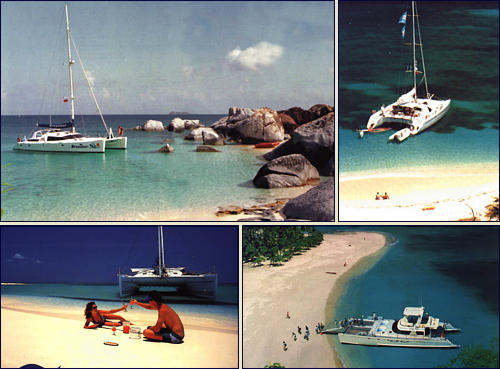 |
|||
|
RunningTideYachts,
Ltd |
|||
